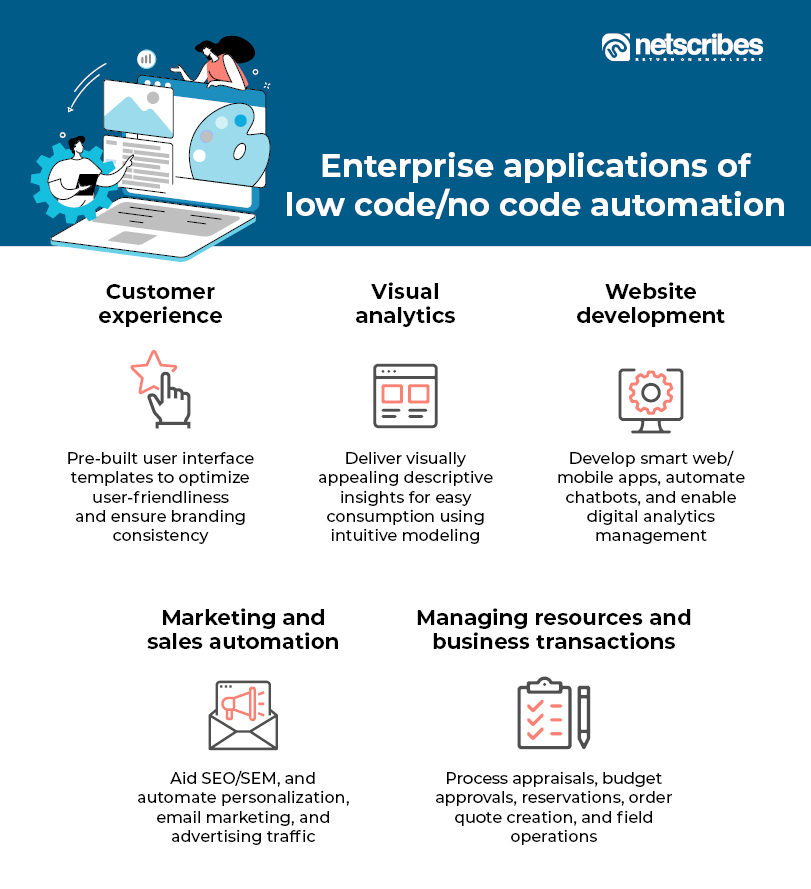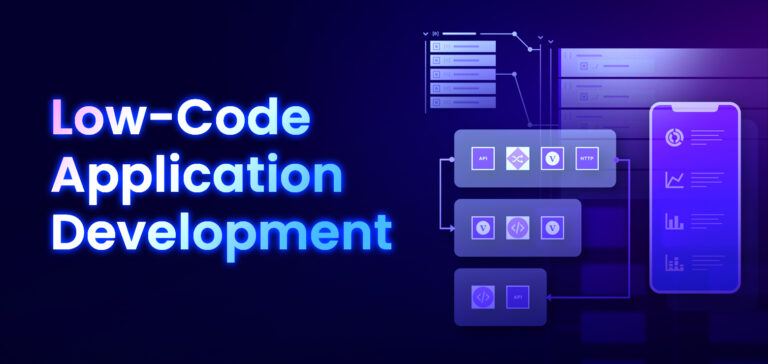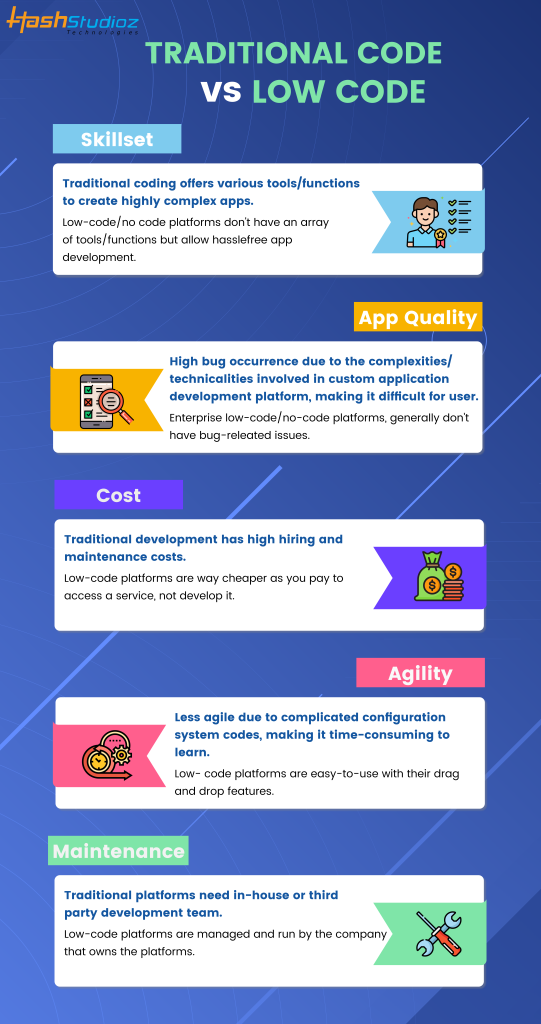Excellent Reasons To Choosing application development with Low-code platforms
Wiki Article
Speed-WiseLow-Code Applications Have Many Advantages.
Low-code application development significantly enhances development speed due to several important factors. Development Environment:
Drag-and-Drop Interfaces: Low-code platforms provide visual tools for designing applications. Developers can use drag-and-drop components to quickly assemble applications without writing a large amount of code.
Pre-built Templates and Components Many low-code platforms come with pre-built templates and components, that allow developers to quickly prototype and build applications without having to start from scratch.
Reduced Coding requirements:
Automated Generated Code: Lowcode platforms write the underlying code, based on the visual models developed by developers. This helps reduce manual code, and speeds up the process of development.
Reusable components: Developers are able to use reusable component in multiple projects, which can reduce the time they spend creating and evaluating code.
Streamlined Collaboration:
Low-code platforms have a myriad of tools that allow seamless collaboration between teams working on development. They include testing, version control and deployment.
Citizen Development (Citizen Development): Users and non-developers of business applications are able to participate in application development making use of intuitive interfaces. This reduces the bottleneck created by limited professional developer availability.
Rapid prototyping and iteration
Fast prototyping: Developers can quickly design prototypes in order to collect feedback and validate ideas, which results in quicker iterations.
Simple Modifications. The visual nature of low-code development makes it easy for users to update and modify their apps.
Pre-built Integrations:
API Integrations. Many low-code platforms include connectors designed for the most popular APIs and services. This could speed up the process of integrating systems.
Data Integration: The instruments integrated into the software simplify and speed up the process of connecting databases, other data sources, and applications.
Deployment Scaling
One-Click Installation: Many low code platforms offer the option of installing with one click, reducing the amount of effort and time needed to install software.
Cloud-Based Solutions: Cloud-based, low-code platforms are able to manage infrastructure and scaling, allowing developers to focus on the application's logic and function instead of deployment logistics.
In general, low-code development has the advantage in terms speed due to its capacity of automating and simplifying many aspects of development. This allows faster delivery of apps and easier adaptation to evolving needs. Read the top Low-code Platform for application development for more advice including rapid app development, microsoft azure sql, azure sql databases, app modernisation, microsoft azure sql, app modernization, azure sql databases, develop web app, azure sql server, rad development and more.

Benefits Of Developing Applications Using Low-Code In Terms Of Scalability And Flexibility
Low-code application development has many advantages when it comes to the ability to scale and flexibility. These are essential for creating applications that are able to adapt to business demands and change with the demands of business. These are the most significant advantages:
Cloud-Based Platforms: Many platforms for low-code are cloud-based. They allow applications to grow quickly and smoothly using the cloud infrastructure. This lets companies handle the increasing demands without worry about managing servers.
Auto-Scaling feature: Built-in features that automatically scale resources in order to satisfy demand, ensuring consistent performance, even without manual input in peak hours.
Flexible Architecture:
Modular Design: Low-code platforms promote modular application design, where components can be created independently as well as tested and scaled. Modularity increases flexibility and facilitates upgrades or expansions of certain components without affecting the entire system.
Microservices Architecture: The Microservices architecture supports the creation of applications by creating a loosely coupled set of services. This improves the flexibility and scalability.
Customizable solutions:
Extensibility: Low code platforms usually allow for customized scripting and programming, which allows developers to extend the capabilities of apps beyond that available out-of the-box. This means that any unique business needs can be fulfilled without any limitations.
Third-Party Integrations: The incorporation of third-party APIs, services or other services allows businesses to increase the functionality of their application by incorporating additional functions.
Agile Development and Deployment
Continuous Deployment and Delivery: Low-code platforms are able to support agile methods, enabling continuous deployment and integration (CI/CD). This allows rapid deployment and update of new features.
Iterative development low-code development is an iterative process meaning that applications can be scaled up and enhanced in a gradual manner. This minimizes the chance of massive changes, while also allowing a controlled growth.
Resource Optimization
Effective Resource Management Low Code platforms maximize resource utilization by using tools that track and control the performance of an application. This helps ensure that resources are efficiently used and are able to be scaled up or down according to actual needs.
Load Balancing: The integrated load balancing feature distributes workloads equally across servers. This enhances the application's ability to handle large volumes of demand, and guarantees consistent performance.
Global Reach
Multi-Region: Platform deployments that use low-code are often accessible across multiple countries which allows businesses to offer low latency access to all users. This is especially important when it comes to applications that have users across the globe.
Localization Support: Built-in localization support lets applications adapt to different languages and regional requirements. This allows them to be more flexible on diverse markets.
Maintenance and updates
Simplified maintenance: The visual and modular nature of low-code software makes it easy to perform maintenance tasks. They allow upgrades and bug fixes to be implemented rapidly without lengthy downtime.
Version Control: Integrated version control systems oversee rollbacks and changes in order to make sure that upgrades can safely be made and that older versions can restored if necessary.
Cost Efficiency:
Low development costs. Through the reduction of coding requirements, low-code platforms cut down on the development cost and permit applications to grow without requiring more development effort.
Pay-as-you go models: Many platforms for low-code offer flexible pricing options, such a pay-as we-go models that align the cost and usage to actual growth.
The majority of low-code applications developers provide a high degree of scalability and flexibility that lets businesses quickly create adaptable and flexible applications. These platforms are able to quickly adapt to the changing needs and efficiently use resources, and constantly improve, allowing applications as well as businesses to expand and grow. Take a look at the top Legacy application modernization with Low-code advice for site info including cross platform app development, azure sql databases, develop mobile application, stored sql procedures, rapid application design, low code development platforms, app development platform, lowcode no code, azure sql server, app platforms and more.

Benefits Of Low-Code Application Development For Collaboration And Workflow
The low-code method of developing applications provides numerous advantages in regards to workflow and collaboration that make it a great option for businesses looking to improve team productivity and speed up their process of development. Here are the top advantages: Improved Collaboration Across Functions:
Unified Development Environment : Low-code platforms offer a unified, single environment where team members are able to work efficiently including designers, business analysts, and other stakeholders. This helps to eliminate silos and promotes better communication.
Visual Development Tools Low-code platforms are straightforward to use and feature a drag-and drop interface. This allows non-technical members of the team to be involved in the process of development and ensures that business requirements are captured in a precise manner.
Communication Enhanced:
Real-Time Co-operation: A lot of platforms that have low-code support live-time collaboration features such as commenting, editing in parallel and immediate feedback. They enable continuous communication by cutting down on the amount of time required for back-and-forth discussion.
Shared Workspaces: Teams may work together in shared workspaces where they can view the, edit and debate elements of the project, making sure everyone's on the same page, and working towards shared goals.
A streamlined Workflow Management System:
Integrated Project Management Tools: Many low-code software platforms include integrated tools for project management which can assist teams to track and organize their projects for development. This includes tasks management, progress tracking and deadline management.
Workflow Automation Automating repetitive tasks as well as workflows can reduce manual mistakes and work and allow employees to focus on more strategic work while increasing efficiency.
More efficient cycles of iteration:
Rapid Prototyping: Low-code platforms enable rapid prototyping and iterative design, allowing teams to develop prototypes, test, and refine applications with shorter time. This means that feedback can be incorporated quickly and changes made rapidly.
Agile Development Support : Support for agile methodologies lets team members work on sprints. They are able to continuously provide small improvements in functionality and more easily adapt to the changing needs.
Accessibility for those who are not developers
Citizen Development: Low code platforms let business users (citizens developers) to build and modify applications, without extensive knowledge of coding. This relieves IT and Development teams of burdens and allows quicker responses to business requirements.
Training and onboarding: Simple user interfaces and comprehensive training materials make it easier to bring new members of the team up to level. This improves the overall cohesion of the team.
Centralized Documentation, Knowledge Sharing and Information Sharing
Integration of Documentation: Low-code platforms often include features to maintain and create documents within the platform, ensuring that all information about projects is easily accessible and centrally located.
Knowledge Repositories: Teams can create knowledge repositories. These include templates, best practices, and reused components. This allows for sharing of knowledge and reduces duplication of efforts.
Consistency in Standardization:
Standardized Components : The use already-built, standardized components gives consistency between applications. It makes it easier for the members of the team to comprehend the various components of a particular project and then work on them.
Governance and compliance Governance and compliance: Integrated governance frameworks ensure that development adheres to regulations and standards of the organization. This reduces the risk of noncompliance, and helps applications comply with quality standards.
Feedback and Improvement:
Integrated Feedback: Low-code platforms provide users with integrated feedback mechanisms which allow them to give easy feedback on applications. This feedback can be later integrated into the application development process.
Continuous Improvement: The capacity to quickly test and implement changes as a result of feedback ensures continuous improvement of the applications. They are aligned closely with the needs of users and business goals.
Visualization & Reporting
Real-Time Analyses: The built-in reporting and analytics tools give real-time insight into the project's performance, progress and user interaction, allowing to make data-driven choices.
Visual Workflow Mapping - Visual tools that map workflows and processes can help teams optimize their workflows by identifying bottlenecks.
For collaboration, low-code software is an excellent way to simplify workflows, bring teams from different backgrounds together and automate tasks. This results in a more collaborative, agile, and efficient developing environment that produces more efficient and high-quality applications.
